HP S700 SSD Review
Why you can trust Tom's Hardware
512GB SSD Performance
Comparison Products
We begin our testing with the 500GB model. This is technically the 512GB capacity class, but we don't have a single drive that gives you access to the full 512GB of capacity. The Crucial MX300 with 384Gbit TLC die features 525GB of addressable capacity and still reserves a sizable spare area for background activity through overprovisioning.
All the comparison products retail for around $150, and that's around $50 less than the HP S700 500GB. The Samsung 850 EVO and Sk Hynix SL308 lead the performance charge. The Crucial MX300, Intel SSD 540s, Mushkin Triactor, Toshiba TR150/OCZ Trion 150 make up the second performance tier. All the comparison SSDs feature a DRAM buffer.
Sequential Read Performance
To read about our storage tests in-depth, please check out How We Test HDDs And SSDs. We cover four-corner testing on page six of our How We Test guide.

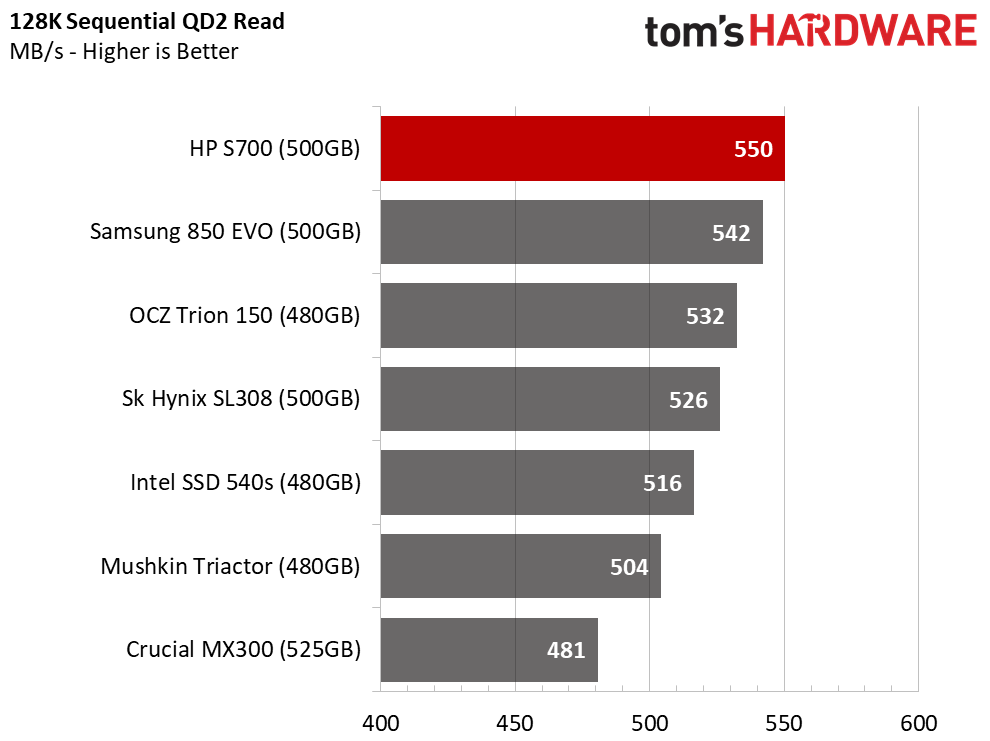
HP and SMI built a fast firmware for reading sequential data. SSDs rarely have an issue in this area, but some technologies take longer to fine tune than others. The S700 with the SMI controller outperforms the Crucial MX300 with a Marvell controller at queue depth (QD) 2. Both drives use the same 384Gbit TLC flash.
Sequential Write Performance
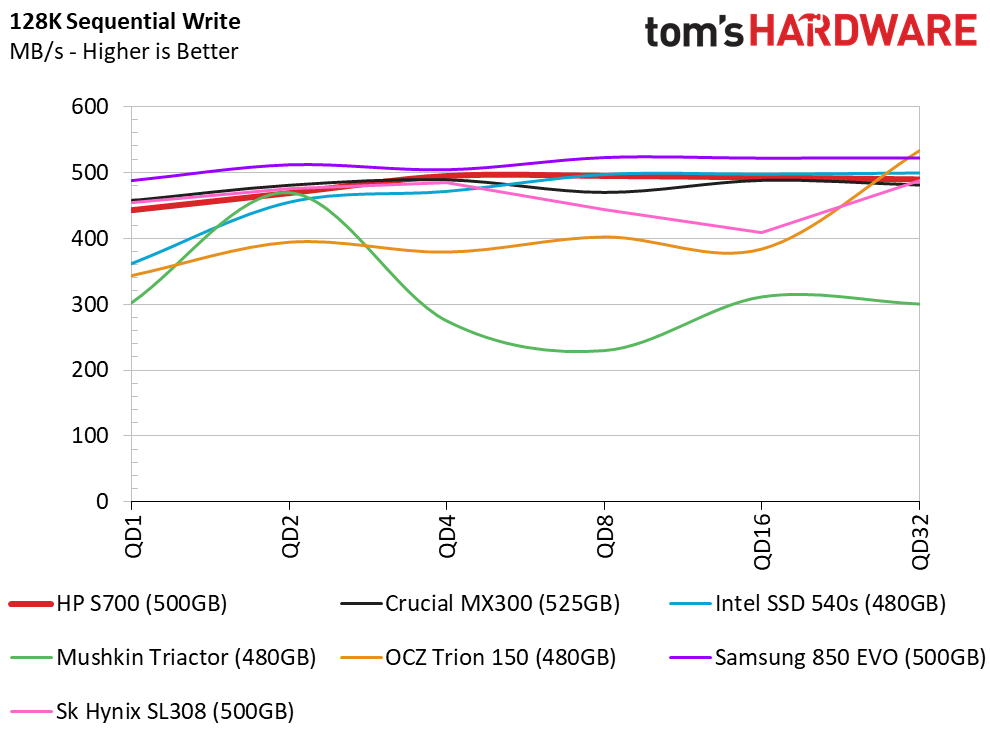
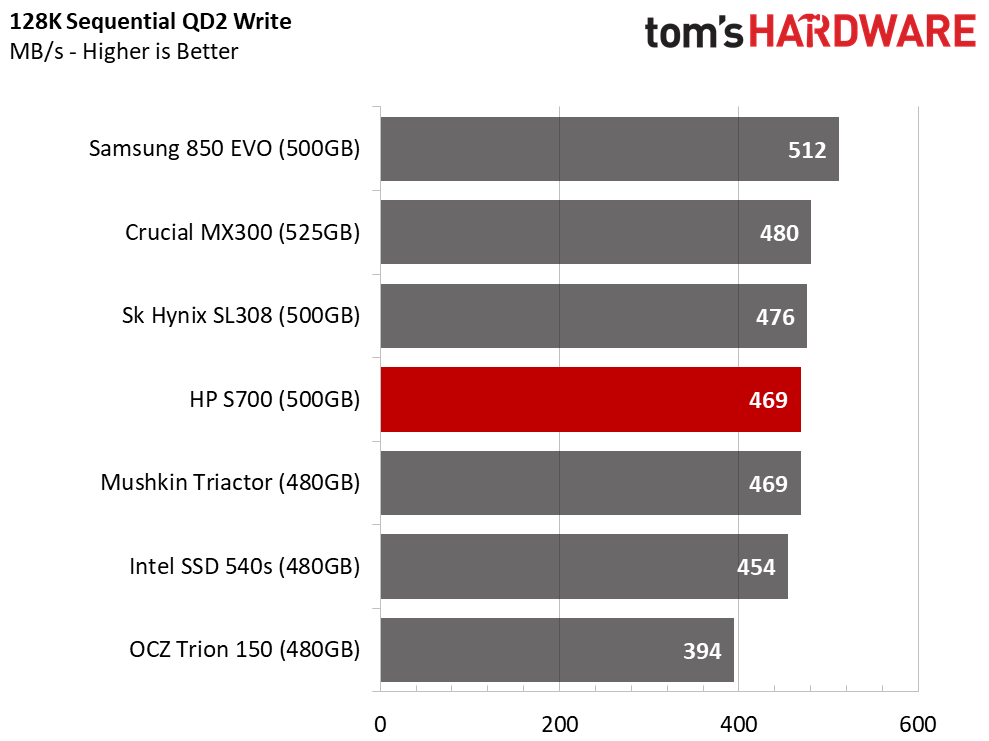
The S700 even delivers respectable sequential write performance. This is also due to firmware advancements, but performance drops as we fill the drive with data. Without a DRAM buffer to cache the abstraction map, data writes slow as the map is populated.
Random Read Performance



The S700's random read performance is much lower than the lower-priced DRAM SSDs in the chart. The S700 is still much faster than an HDD, but it's slower than most older SSDs.
Random Write Performance



Surprisingly, the S700's random write performance is better than we expected. The drive still sits second to the bottom of our low-QD bar chart, but it's competitive.
Get Tom's Hardware's best news and in-depth reviews, straight to your inbox.
80% Mixed Sequential Workload
We describe our mixed workload testing in detail here and describe our steady state tests here.
DRAMless SSDs don't tend to scale with queue depth in mixed workloads, and the S700 isn't any different. We observed just over 300 MB/s in this test.
80% Mixed Random Workload
Mixed random performance is similar. The S700 delivers around 9,000 IOPS during the test, and that doesn't change much as we increase the workload.
Sequential Steady-State


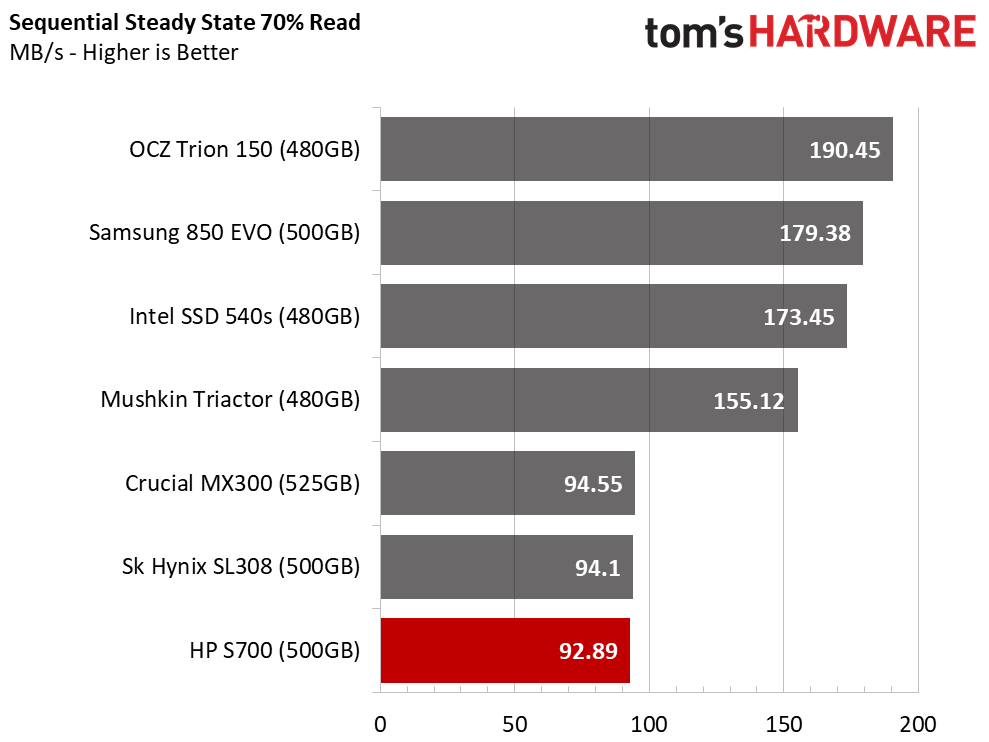
Entry-level SSDs are not designed for steady-state conditions, and that carries over to all very low-cost storage products. With that in mind, the S700 still managed to nearly match the Crucial MX300 and Sk Hynix SL308.
Random Steady-State
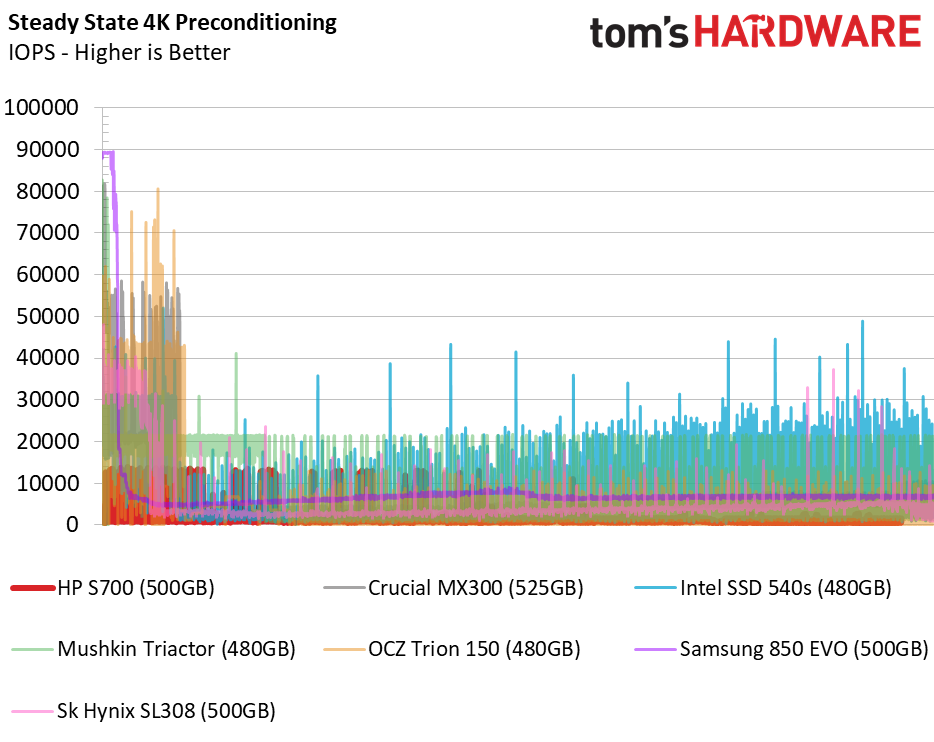

The steady-state random write test shows very low performance in a worst-case scenario.
PCMark 8 Real-World Software Performance
For details on our real-world software performance testing, please click here.







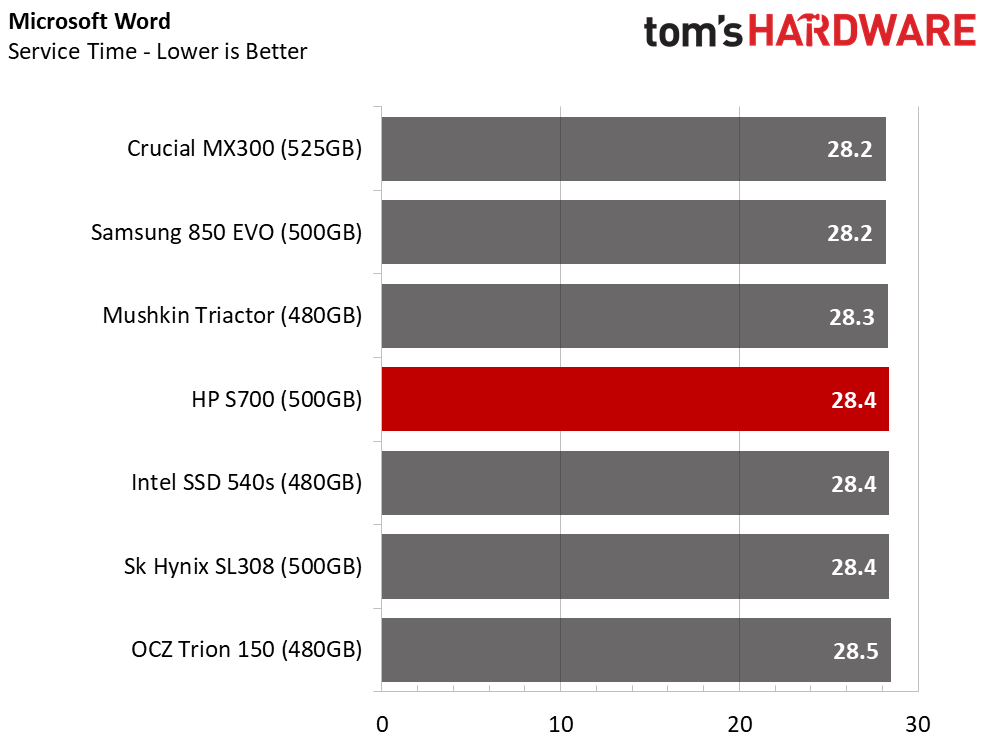


Companies like to tell us that DRAMless SSDs deliver enough performance for consumer workloads while reducing power consumption and cost. In the next few tests, we'll examine those claims and see where this product makes the most sense.
Application Storage Bandwidth
A high-performance consumer HDD (oxymoron?) delivers around 25 MB/s in this test. The HP S700 500GB provides a 10x improvement over a modern 7,200-RPM spinner.
PCMark 8 Advanced Workload Performance
To learn how we test advanced workload performance, please click here.

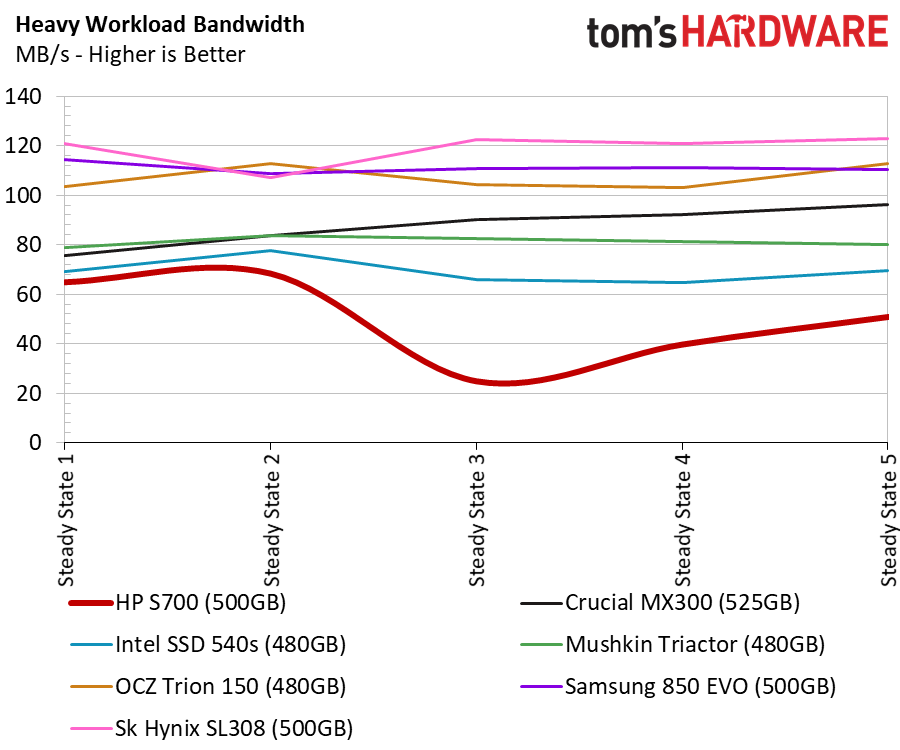

Compared to modern SSDs, DRAMless drives like the HP S700 are more like the early consumer SSDs. The price should offset the heavy performance regression.
Total Service Time



The DRAM buffer isn't an expensive component compared to the flash itself. Flash is the most expensive component in all SSDs, so losing the DRAM package eliminates only a small sliver of the overall price, yet performance takes a big hit. The latency penalty is very high even during light workloads. The S700 is still faster than a hard drive, but the performance results show it's not as good as a modern mainstream SSD.
Disk Busy Time
The high service time calls into question the power-savings of DRAMless SSDs. The drive loses a component consumes a lot of power, but that is offset by the amount of time the drive has to work to complete the same tasks.
Responsiveness Test


In these tests, we included the HP S700 Pro with a DRAM buffer and a slightly different SMI SM2258 controller. The first chart measures the system responsiveness (latency), and the second shows the amount of power each Lenovo Y700-17 consumes during the test. The S700 Pro used a lot of power, but the DRAMless S700 uses even more.
The responsiveness score looks like there is only a slight disadvantage for the S700, but this is a very sensitive test and every point counts.
Notebook Battery Life


The notebook battery life test shows us that DRAM-equipped SSDs can actually increase notebook battery life. This isn't what controller manufacturers claimed two years ago when the first DRAMless SSDs crept to market. Since that time, the controller manufacturers have slowly pulled back the power saving claims. Most of the companies use the same software we do, so it's easy to see why they don't push the power consumption marketing message now.
MORE: Best SSDs
MORE: How We Test HDDs And SSDs
MORE: All SSD Content

Chris Ramseyer was a senior contributing editor for Tom's Hardware. He tested and reviewed consumer storage.
-
mapesdhs Still the non-zero-origin graph for the sequential read results; really needs fixing. Other than that, thanks for the review!Reply -
mapesdhs PS. The forum mechanism is *completely* broken. Took ages to get the page in a logged-in state to post the above (forum link doesn't work properly); I wanted to edit my message but the .co.uk site keeps redirecting incorrectly, both sites fail to remember login details, the comment submission button often produces in invalid form error... it just goes on and on. Why is the toms forum system such a mess?Reply -
derekullo Reply20408892 said:PS. The forum mechanism is *completely* broken. Took ages to get the page in a logged-in state to post the above (forum link doesn't work properly); I wanted to edit my message but the .co.uk site keeps redirecting incorrectly, both sites fail to remember login details, the comment submission button often produces in invalid form error... it just goes on and on. Why is the toms forum system such a mess?
Yeah, the Tom's new forums reminds me of the Intellilink episode of south park...
http://southpark.cc.com/clips/pcqo6r/intellilink-is-amazing
-
Zaporro whats the point of even listing interface speed if devices dont make full use of it? interface type sure, thats important but speed is meaninglessReply
"oh look at our drive, its 6Gb/s interface speed, and lest completely forget that we are bottlenecked at controller speed (SSD) or plate speed (HDD) maybe customer is too stupid to find out"
for HDD even SATAI was enough for most of them
when SSD started appearing SATAIII was a standard already and just, it seems that fastests SSD's in 2.5" factor form reach ~550MB/s which still has plenty of headroom in SATA3 theoretical 750MB/s
the "Technical specification" table should list actual read/write speeds first before the useless interface speed, that what an user would expect from a serious technical review site... -
mapesdhs Reply20409992 said:... it seems that fastests SSD's in 2.5" factor form reach ~550MB/s which still has plenty of headroom in SATA3 theoretical 750MB/s
Ten seconds in a search engine would find the answer. To quote MariusMatutiae from howtogeek.com:
"While data is actually sent at 6 Gb/s, it is encoded to counteract two common defects in telecommunications, DC Bias and Clock Recovery. This is often accomplished using a specific coding algorithm called 8b/10b Encoding. It is not the only encoding algorithm which has been devised to this end (there is also a Manchester encoding), but it has become the de facto standard for SATA data transfer.
In 8b/10b encoding, eight bits of signal are replaced by 10 bits of (signal + code). This means that, out of the 6 Gb the channel sends in a second, only 8/10 (4/5) are signal. 4/5’s of 6 Gb is 4.8 Gb, which in turn equals 600 MB. This is what degrades the 6 Gb/s channel into a mere(?) 600 MB/s channel.
The advantages obtained by compensating for DC bias and allowing for Clock Recovery more than compensate for this slight degradation."
In reality, with other overhead issues factored in aswell, SATA3 tops out at around 550MB/sec, as confirmed by PCIe models based on the same technology as their SATA3 counterparts.
Ian.
-
WyomingKnott "It's not a heart-racing combination, but it's still faster than a hard disk drive under most workloads." Under most workloads? They've managed to slow SSDs down to the speed of hard drives?Reply -
mapesdhs Reply20421269 said:"... They've managed to slow SSDs down to the speed of hard drives?
It is kinda nuts. I bet if mainstream and good SSDs from a few years ago were included in modern test results, instead of only current models, a lot of the current products would look pretty rotten. As long as this trend continues, I just keep looking for lightly used 840 Pro and other decent models (Vector, Neutron GTX, Vertex 4, etc.)
Ian.






